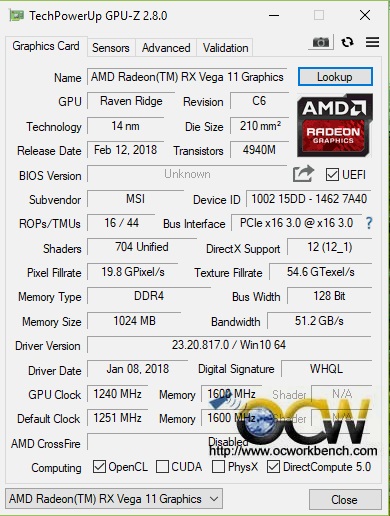Review of AMD Ryzen 5 2400G
5 Mar 2018
Page 1 – Introduction
Page 2 – Test Setup, CPU-Z,GPU-Z Results , Overclocking
Page 3 – Cinebench R15
Page 4 – PC MARK 10
Page 5 – 3DMARK FireStrike
Page 6 – World of Tanks Encore and Final Fantasy XV benchmark
Page 7 – Conclusion
Introduction to Ryzen 5 2400G
AMD has been capturing the desktop processor market with it’s Ryzen series of processors since last year. Although the desktop processors runs fast, the lack of a integrated graphics is a better option if it wants to match the performance against Intel. In Feb 2018, AMD released two APU based on the “Zen” architecture – the Ryzen 2000G “Raven Ridge” series.
The chips combine a quad-core “Zen” CPU with an integrated graphics core based on the “Vega” graphics architecture, with up to 11 NGCUs, amounting to 704 stream processors. The company is initially launching two SKUs, the Ryzen 3 2200G, and the Ryzen 5 2400G. Besides clock speeds, the two are differentiated with the Ryzen 5 featuring CPU SMT, and more iGPU stream processsors. The Ryzen 5 2400G is priced at USD $169, while the Ryzen 3 2200G goes for $99. Both parts will be available on the 12th of February, 2018.
The Ryzen 5 2400G is a 4C 8T processor clocked at 3.6 GHz and boosted to 3.9 GHz. It has 2 MB of L2 cache (512 KB per core), and 4 MB of shared L3 cache; and Radeon Vega 11 graphics (with the 11 denoting NGCU count), featuring 704 stream processors. The iGPU engine clock is set at 1250 MHz. The dual-channel DDR4 integrated memory controller supports up to 64 GB of dual-channel DDR4-2933 MHz memory.
The Ryzen 3 2200G is a reduced version of the 2400G. It runs a 4-core/4-thread CPU ticks at 3.50 GHz, with 3.70 GHz boost. Its CPU cache hierarchy is unchanged; the iGPU features only 8 out of 11 NGCUs, which translate to 512 stream processors. The iGPU engine clock is set at 1100 MHz. Both parts feature unlocked CPU base-clock multipliers; and have their TDP rated at 65W, and include AMD Wraith Stealth cooling solutions.
The APUs launched at the right time especially when graphics card are expensive. As it runs on the AM4 socket, existing X370 or Ryzen compatible boards are able to support it by updating the BIOS. DIY users can just replace their existing Ryzen 1300 with a brand new Ryzen 2400G and it also comes with integrated graphics. Just hook up the HDMI port and you have a very entry level PC setup running.
In this review, we will investigate the performance of the Ryzen 2400G and see if it is able to compete against it’s competitors and how well it overclocks.

